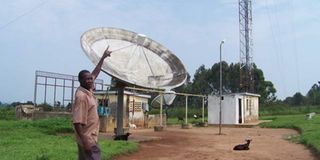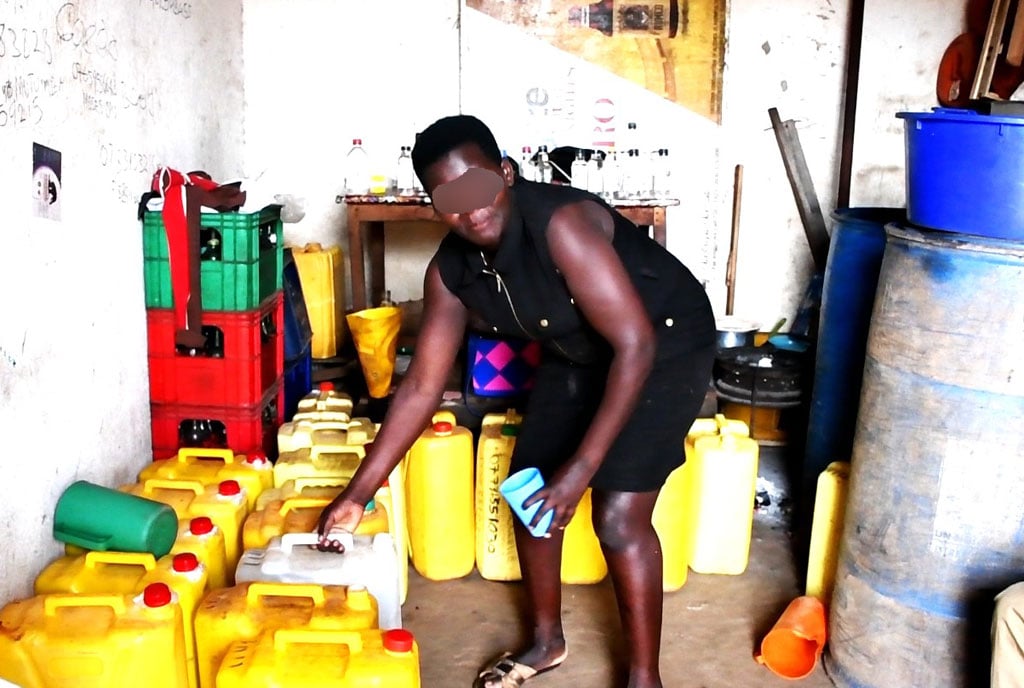Prime
Arua earth satellite station rots away

Site technician Yoram Badang in front of the earth satellite station in Arua District.
Arua- The destruction of the only earth satellite station and medium wave station in Arua District in 1979 has left scars on the Information and Communication Technology (ICT) in the region.
Though Idi Amin was said to be illiterate, he realised the importance of the facilities and ordered for their establishment. The satellite was used for military communication and television while the medium wave was strictly for radio.
After the war that ousted Amin, the earth satellite located in Ombaci, about 4KM north-west of Arua Town, and the 10KW medium wave transmitter in Giligili in Ediofe, were vandalised and abandoned. The satellite station sits on 12 acres of land while the one at Giligili sits on five acres. The facilities were constructed by Harris Company, a US firm, in 1976.
The stations are now bushy. They provide palatable grass for rearing animals and have also been turned into farms by residents who encroach on the government land. Security at the multi-million facilities remains lax.
According to Mr Yoram Badang, a technician at the site, the satellite was used for military communication and also to relay television stations from the outside world.
Live images
Ugandan Television viewers at the time watched live for the very first time the annual pilgrimage to Mecca. Infrastructural investment as part of media development began after independence and continued with successive post-independence governments.
Soon after its construction, the now abandoned station was used to broadcast to North America and Europe. After the fall of President Idi Amin, it was taken up by Uganda Post and Telecommunications Corporation. The 150 meters-tall tower, said to be tallest in East Africa, is now being used by BBC and UBC.
However, the unprotected satellite lays run-down with most of its valuable components looted and vandalised.
“If power is off, then BBC goes off since there is no standby generator. We only receive power from Wenreco and the place has not been used for television broadcasting. Communication can be made easier if these sites are revived since the world is globalised with improvement in ICT,” Mr Badang said.
Between 2004 and 2009, Bonfree Television Network (BTN) and Nile FM hired the satellite antenna at Shs2 million per month, but where forced to relocate since it had become expensive for them.
The former President’s son, Mr Jaffar Amin, said: “Idi Amin should be remembered for linking Uganda directly to the rest of the world by putting up earth satellite stations at Mpoma in Mukono District and Ombaci in Arua District.”
“Sadly, the 1979 liberation forces from Tanzania decided to bomb the Arua earth satellite station, apparently because they saw it as an extension of Idi Amin Dada who had eluded them. Today, 2013, no signals reach or leave Ombaci Satellite Station but the huge dish is still there for all to see and remember as another momentous legacy to the positive side of Idi Amin Dada.”
In a 2008 visit to the defunct sites, the chairman Parliamentary Committee on ICT then, Mr Edward Baliddawa, said the government must refurbish the satellite and MW transmitters to improve communication that is crucial in boosting trade across the district and neighbouring countries.
“It is disheartening to see these valuable assets wasted yet we have a government in place. People can use this for internet services and start radio and television stations to improve on their income,” he said. Mr Baliddawa said vibrant ICT must propel all stakeholders to rejuvenate the existing crumbling structures. He also added that revitalisation of ICT related tools can make institutions and markets productive, enhance skills and learning, improve governance and make it easier for the poor to access services and make their voices heard.
“This is wastage of government wealth which could see Ugandans reap benefit from it,” the MP added.
Billions lost
Mr Baliddawa said there was need to revitalise the ICT industry in the district through the existing structures. He said the government loses billions of income from such abandoned structures, which the trend has to be reversed.
The chairperson Parliamentary Committee on ICT, Ms Paula Turyahikayo, said the status of the satellite should be studied to in-depth so that the government could be asked to revive it. “Satellite is a very expensive venture to set up, but if the equipment could be replaced with modern ones to fit into the digital world, it would be good because satellite offers broad communication opportunities,” she said.
Former Arua District chairman Richard Andama Ferua said the local community suffers with high rate of internet services, which could be made cheaper if the dishes and masts are refurbished. For instance, internet rates are now at Shs50 per minute in places in the town.
In 2002, the government announced plans to install new transmitters at a cost of $3.4 million (about Shs8.4 billion) through a World Bank-funded project. The project kicked off simultaneously at Arua and Lira stations and it was supposed to be carried out at 10 stations across the country.
So far transmitters at Kabale and Mawaga have been installed, but the residents are asking when the one in Arua, that would serve the north and eastern regions, will be installed.
Importance of satellites
Satellite communications links add capacity to existing communications capabilities and provide additional alternate routings for communications traffic. Satellite links, as one of several kinds of long-distance links, interconnect switching centres located strategically around the world.
They are part of the defence communication systems (DCS) network. One important aspect of the satellite communications network is that it continues in operation under conditions that sometimes render other methods of communications inoperable.
Because of this, satellites make a significant contribution to improved reliability of Navy communications. The reliability of satellite communications systems is limited only by the equipment reliability and the skill of operating and maintenance personnel.
There are also nine types of satellites that perform different functions. This include, astronomy, atmospheric studies satellite, navigation, communications, reconnaissance, remote sensing satellite, search and rescue, space exploration and weather satellite.




